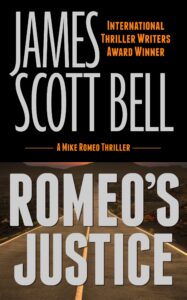by James Scott Bell
@jamesscottbell
 The news is obviously a great place to find plot ideas. I used to clip news items from actual newspapers and toss them in an “idea box.” When getting ready to develop a new novel, I’d go through the box looking for something that still grabbed me and could be the basis of a story, or at least provide an interesting subplot.
The news is obviously a great place to find plot ideas. I used to clip news items from actual newspapers and toss them in an “idea box.” When getting ready to develop a new novel, I’d go through the box looking for something that still grabbed me and could be the basis of a story, or at least provide an interesting subplot.
An example is my latest Mike Romeo thriller, Romeo’s Justice (which, as it happens, launches today, at the deal price of just $1.99. What a coincidence!)
For Romeo’s Justice I riffed off a story I read about the mining of lithium in California’s Salton Sea. That’s obviously timely, as electric vehicles (EVs) are being…encouraged…and lithium—lots and lots of lithium—is needed for manufacturing EV batteries. Thus, there is a rush for “white gold” and the Salton Sea is the new Sutter’s Mill. This provided both a setting and a subplot for my novel.
That’s one way to use the news—find an issue of current moment and either weave it into the narrative or make it the foundation for the main plot. Goodness knows, there are plenty of issues to choose from these days, but a word of caution is in order. A novel is not a sermon, extended rant, or thinly-disguised jeremiad. It is not 80k words worth of Twitterspeak (or should I say Xtalk?).
You’ve got to play fair with the characters. You have a strong opinion, fine, but make sure it is dramatized and not hammered. Give characters with the opposing view a justification (even if it’s just in their own minds) for what they are doing. Otherwise, a good portion of your potential readership will likely skip your other books. If they want to get yelled at they can doomscroll on X for free.
There’s another way to use headline ripping, and that’s taking an actual event and using it as the main plot. Now you’re dealing with real people, and the primary caution here is defamation.
Now, libel cases are notoriously difficult to sustain, especially in the fiction context. Though not impossible. There was the case some years ago of a novel called The Red Hat Club in which the author based a character on her (former) friend. The character in the novel is “an out-of-control alcoholic, who drinks during flights. She has sex with ‘stud puppies’ and married men, dresses provocatively, acts rude and crude, and is labeled as a ‘right wing reactionary’ and atheist with an awful temper.”
The ex-friend was not happy about this. She sued, and since she was not a “public figure” (thus bearing a more favorable burden of proof) she won.

Blue-footed booby
And so, while libel cases against novelists are as rare as the blue-footed booby, there are a few simple things you should do just to be safe.
Of course, put in the standard disclaimer: This is a work of fiction. Any resemblance to actual persons, living or dead, is purely coincidental.
But also change key facts. For example, if the real person is a man, consider making the character a woman. If he’s a lawyer, you could make him an investment banker. If the event happened in New York, set it in Los Angeles.
At the very least, change the name, for goodness’ sake. The TV show Law & Order uses real events all the time. They always run their disclaimer, then usually do an episode based on a real crime. They change things around, but one time they got lazy. In a story with the headline Was a Law & Order Episode Ripped Too Closely From the Headlines? the Hollywood Reporter documented an episode where a Brooklyn Supreme Court judge accepts cash bribes from a bald, Indian-American lawyer named Ravi Patel.
A bald, Indian-American lawyer named Ravi Batra sued the show’s creator, Dick Wolf. “In real life, Batra had close connections with a New York politician who allegedly accepted bribes and was said to have influence over a a Brooklyn Supreme Court judge.”
Defendant Wolf moved for summary judgment (a dismissal of the suit as a matter of law). But a judge denied the motion, holding that there was “a reasonable likelihood that the ordinary viewer, unacquainted with Batra personally, could understand Patel’s corruption to be the truth about Batra.”
I don’t know what ultimately happened to the case; I suspect it was settled shortly after this. But the show could easily have changed the first name of the character. Or made him a Greek-American named Xander Papadopoulos. It was careless not to.
So remember the two Ds when riffing from headlines: Disclaimer and Differences. Do that and you’re golden. (Memoir writing is another kettle of carp. See this article over on Jane Friedman’s site.)
Speaking of headlines, I can’t resist sharing a few of my favorites, gathered over the years. These are real:
Milk Drinkers Turn to Powder
Iraqi Head Seeks Arms
Something Went Wrong in Jet Crash, Experts Say
Include Your Children When Baking Cookies
Squad Helps Dog Bite Victim
Red Tape Holds Up New Bridge
Juvenile Court to Try Shooting Defendant
Complaints About NBA Referees Turning Ugly
Do you use the news for inspiration? Or just frustration?
And don’t forget:


Your list of headlines made me laugh. Thanks.
I don’t know if it’s true, but I read once that William Faulkner was obvious in his use of thinly disguised real people in his books, but that no one said anything because they weren’t about to admit they were those horrible characters. I’ve had people ask me if a character is based on so-and-so and I tell them honestly, no. I had one lady write me asking about who I’d based a hero in a romance on, and her words made her sound like whoever it was, she was coming after him. I don’t think some people can grasp the fact that writers can imagine a person who doesn’t exist.
Harlan Ellison was bullied as a kid, and used those real names later in his stories, as horrible people. Because he wrote SF, it was clear there were no truth claims.
Harlan found a productive (and legal!) way of channeling his anger.
There’s a whole outside layer to my mainstream trilogy, summarized in my characters as two group characters – Good Fans and Bad Fans – and includes critics, gossip, internet stories, People Magazine-like articles… This is the world which surrounds the world-wide film industry, and can make or break an actor or a movie by controlling ‘the narrative.’
The startling thing is that I keep finding something similar to what I’ve written or plotted in the daily news, FB, and modern sources, even though I wrote most of mine years ago. Nothing changes much, I guess.
I consider these chance encounters both validation, and proof to myself that I’ve done enough homework (I read the gossip rags at the dentist’s office, etc.). The internet makes it SO easy if I need to go back in time and fill in my understanding of a scandal, and Youtube and other videos can put me on the actual set of a movie premiere or the Academy Awards.
It can take a lot of time – but I think the details being right on makes it all worthwhile – that’s my homework so the reader doesn’t have to work TOO hard.
It’s also really useful when you have plot holes to straighten out.
I think the detail work is worth it, too, Alicia. Even for those not familiar with the setting or events, there’s a feel of realism that elevates the story.
I just noticed today that Robert Heinlein included a character named “Dr. Van Rhein-Smitt,” a university president. I doubt if USC’s Rufus B. Von KleinSmid sued Heinlein, especially when he described his character as “having beautiful white hair” and “America’s Handsomest University President.”
Ha, that’s a good point, J. A favorable portrayal is non-actionable.
The story is “Life-line,” and, for all his praise, Heinlein makes his “Dr. Van Rhein-Smitt” seem like a bit of a pompous ass.
http://about.usc.edu/files/2011/07/vonKleinSmid_Rufus-B-241×300.jpg
Chancellor Von KleinSmid used to wander about USC in his homburg and black suit, greeting students with a kindly, “Good morning!” Anyone who responded, “Hi, Rufus,” were informed that his friends always addressed him as “Barney.” I just said, “Good morning!” whenever he spoke to me.
One Christmastime, he asked my sister’s friend, Neil, who worked in a department store, where the “David Crockett” outfits could be found.
The news is a great source of story inspiration even from a historical standpoint. Very fascinating to go through old papers and see the kind of things reported in the news. I’m such a nerd I wish I had more time to do that. LOL!
As to real people, I have a few town council members in the current historical mystery and started out using real names from the time. But in the end, even though they are in no way implicated in any crime in the story, I ended up changing them. For my sanity, I figured it was better to make sure all names in the manuscript are fiction (well, all but President Wilson) than to try and remember who was fictional and who was real. It’s a bummer–you’d like to give a shout out in historical fiction to people who were actually there, but the whole libel thing doesn’t make it worth it.
Loved the headline examples. I occasionally see a few like that when checking online news and need to remember to write them down! 😎
When I did my Kit Shannon books, set in early 1900s Los Angeles, I spent hours and hours at the downtown library, looking at microfiche of the Times and Examiner (the Hearst paper). So much to take in, including the advertising. I picked up plot ideas, but also so many wonderful little details of the era. I filled two binders with notes and copies of newspaper stories. Still have ’em.
Someone asked CJ Box if any of his characters were based on real people, and he said they were, and that people claimed to recognize themselves and were thrilled. Someone else asked if the politicians he described less than favorably gave him any flak, and he said, “Those people never recognized themselves.”
I hate the news these days and avoid it, although I’ll come across articles in my research (such as the claims that aliens were the cause of cattle deaths in Colorado), and yeah, I used that one.
Yeah, avoiding the news these days is like avoiding the sun in Phoenix. At least every now and then you get a ray of light you can use.
Jim, your headline examples are a hoot. Reminds me why I miss a physical newspaper with morning coffee.
Lithium mining is a great topic, esp. in an environmentally sensitive place like the Salton Sea. My BIL used to be a park ranger there. Congratulations on another exciting Romeo adventure!
Most of my books start from news stories. The latest is Deep Fake Double Down about (guess what) deep fakes. Other subjects have been a terrorist attack on the power grid, covert drone surveillance, people going missing during Hurricane Irma. The news is a never-ending source of ideas. We’ll never run out of inspiration.
Thanks also for the good info about libel in fiction. I’ve wondered about L&O b/c they are so close to real events. But Dick Wolf can afford to fight a libel suit.
Ha. We humble authors without deep pockets are better served by the two Ds!
The headline examples you shared are hilarious, Jim. Sometimes I wonder if the authors don’t write them intentionally just to see if anybody’s paying attention.
None of my characters could be mistaken for people I know. I may use different traits—a hair color here, an attitude there—but never the whole package. In my middle-grade WIP, the 10-year-old main character is writing a novel, and the antagonist in her book sounds suspiciously like a mean girl who’s been giving her a hard time. A wise adult gives my hero a warning very similar to what you told us here.
We can use more wise adults, Kay. Where’d they all go?
Excellent topic, Jim. In my latest, I used two real stories of orcas. With one, I included it to show how deeply they feel emotions, in dialogue between characters. The second story backfired on me. When I included it, the orca was alive. By the time I finished, she passed. Which left me with a conundrum. Do I rewrite the scene, change the names, or include an author’s note at the end? I chose the latter. At the time my story takes place, she was alive. But I fear some readers will pick up on it. Since the book doesn’t release till October, I may end up changing the names and then explain why in the author’s note.
You bring up a good point, Sue. When we use real events the story may change significantly between the time we start writing and publication. One benefit of being an indie is that you can move relatively fast.
I don’t think you have to explain or apologize, Sue. If the story works, readers (those who know about the real story, that is) won’t hold it against you. They know it sometimes happens.
Thank you for lifting the weight off my shoulders, Jim! I’ve been struggling with how to handle it. Never been in this position before.
Congratulations on Romeo’s Justice publishing today, Jim. Happy book birthday!
In my “Empowered” novels I played off of history’s headlines. A crucial moment was the “Missiles of September”, in September 1962, where President Nixon (who had won in 1960) deals with an analog to the Cuban missile crisis a month earlier, which leads to a limited but still devastating nuclear exchange, the legacy of which still shapes the world of my heroine nearly sixty years later.
I haven’t used news stories per se in the Meg Booker series, but I have plenty of library stories to draw on, and of course, fully fictionalize. The same goes for my cast of characters, who are fictional, but some of whom reflect aspects of people I knew.
The science fiction writer Bob Tucker used to name a minor character after someone he knew, such as a fellow SF writer or fan, as an homage and an in-joke. Nothing defamatory.
Love your alternative history premise, Dale. I like that genre. I should try it sometime!
Something Went Wrong in Jet Crash, Experts Say
Ha! Since I used to work for the local rag in my area, these headlines tickled me no end.
Just downloaded Romeo’s Justice…congrats! It’s, so far, my fave Romeo story. Amazon review forthcoming.
When I wrote The Master’s Inn, it’d first been birthed as a play, which I directed in my town. The characters in the play were all friends of mine; one character was my teenage granddaughter.
So, when I wrote the novel, all of these real people were living in my head. I’m sure that they influenced my characterizations . . . just a bit, right?
I wonder if readers who also know these real people recognize them in the novel.
Happy Sunday! 🙂
Hey Deb, thanks for the encouraging word on my new Romeo. Greatly appreciated!
Congratulations, Jim. I occasionally use “ripped from the headlines” elements in my novels, but I’m careful to change the key elements.
That’s all you have to do, Elaine. Thanks for the good word.
Most of the time the stories I see in the news spark an idea…Love the new Mike Romeo book! Submitted a review today.
Thanks, Patricia!